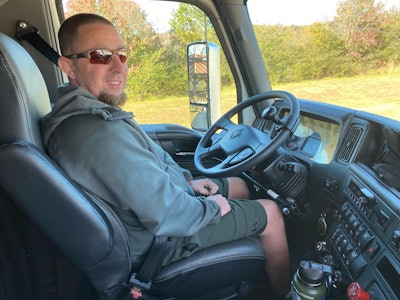Doug Teal always wanted to be a truck driver, having "dreamed about driving since I was a kid," he recalled.
He got a late start, as many drivers do, and in February 2022 obtained his commercial license at the age of 37. Teal landed a job driving teams, hauling produce weekly between Mt. Airy, North Carolina, and California – about 2,500 miles one-way.
"Driving was one of the only jobs I ever enjoyed that I had, and I was making good money," Teal said, with emphasis on was and had.
Teal was living his dream for barely three months when a freak accident at home ended all that.
"I was in my yard, and I was riding my four wheeler around," he recalled. "I got off my four wheeler, there was a dangling tree, and I pushed it, and then it sent me flying to my back. I broke my back at T7. I drove for 90 days and some change, then I got hurt."
The T7 vertebra is roughly halfway down the back and has a pair of ribs attached. Teal was more than hurt. He was paralyzed.
"I'm what you call a T7 complete injury," he said. "I have nothing from a little bit below the chest plate down."
Bound to a wheelchair, Teal sat on the sidelines as freight rates tanked and stagnated and there were too many trucks and too little freight. It wasn't the best of times to be a driver, but he didn't care. For those two and a half years, Teal knew he still wanted to be a truck driver, and he wanted it bad.
A long way to go
 Doug Teal was a truck driver for just more than 90 days, hauling produce coast-to-coast, before he was paralyzed in an accident in 2022. Hand controls mounted to the steering wheel allow him to use the throttle and accelerator.
Doug Teal was a truck driver for just more than 90 days, hauling produce coast-to-coast, before he was paralyzed in an accident in 2022. Hand controls mounted to the steering wheel allow him to use the throttle and accelerator.
There's 1,273 miles between Thornton, Colorado, and Hanceville, Alabama, and close to 24 hours under the best traffic conditions.
Hanceville is a small town in Cullman County, Alabama, with a population of around 3,300. But if you're confined to a wheelchair and want to drive a commercial truck, Hanceville is the place to be.
Scouring the internet for options that could get him back in the cab, Teal discovered a bit of a rarity in CDL training: a class for wheelchair users. Energized by the possibility to reclaim his independence, fulfill his childhood dream, and possibly inspire others like him along the way, Teal headed south from his home just outside of Denver and enrolled in Wallace State Community College's CDL program – the only one of its kind that Teal could find.
"Denver is really handicapped friendly – more than any other state I've been to," he said, "and we don't have anything to do with trucks. People are like, 'I don't know how you'll ever do that.'"
Many carriers hire and accommodate professional drivers with disabilities, but getting a CDL as a wheelchair user is complex. Applicants still must pass the DOT physical exam and complete training and testing, but would-be drivers with missing or impaired limbs also need to pass a Skill Performance Evaluation (SPE).
Teal never surrendered his CDL after his accident, but he needed to clock some seat time with the specialized equipment he'd need to use as part of the SPE, and that equipment for training, he said, is practically non-existent.
"There's not even a truck around you can find with hand controls in it," he said. Teal uses hand controls for the brake and throttle. "I talked to dealers that install them around the country. Nobody wants to touch the truck. Everybody's scared of it."
There's no fear in Hanceville.
How it works
Wallace State's CDL program provides specialized equipment, like trucks equipped with those very hand controls that surround the steering wheel and are connected to the pedals. The school is also equipped with a lift to help get wheelchair users in and out of the truck.
Words like "specialized" and "equipped" make it sound fancy, when the truth is most of it is the result of the school and the instructors figuring out a way to make what they have work.
"We have a portable lift that picks the people up and swings around," said Don Stepp, a third-party examiner for the state of Alabama and one of five CDL instructors at Wallace State. "Sets them right in the truck."
The lift is moved around the yard by a Kubota side-by-side.
"It looks like a little lawnmower seat," Teal said. "You transfer onto the lift, and the lift would pick you up and put you all the way in the truck. You transfer over to the truck seat from that lift, and then you're in."
Getting in and out of the truck is only a small part of driving it and an even smaller part of safely hauling a load. There's pre- and post-trip inspections, dropping and hooking, and everything else that comes with being a trucker. Imagine having to do all those things if you can't stand, squat or kneel.
"We have a wheelchair that is a lift-type wheelchair that we put them in because they have to be able to stand up and do their unhooking of the fifth wheel and air lines and all that," Stepp said.
"Inspecting the trailer is pretty easy," Teal added. "I can just kind of duck right underneath there and pretty much get to it. But the truck, I just turn the wheel and I can look in there and feel it."
The hand controls that wheelchair CDL students use for speed and the brakes are the only modifications made inside the cab, and they're practically the only modifications made to the truck or trailer.
"Right now, the only thing I've done to a truck as far as modifying the truck is I've took the steps off the rail because you can literally stand right there if you're not in the wheelchair and hook everything up," Stepp said. "But taking them off allows the wheelchair to come up a little bit closer to the truck and then stand up. Other than that, the truck and trailer is just like the same truck everybody else uses."
Getting back on the road
 While it's not part of a standard CDL curriculum, Doug Teal will have to unhook, drop and rehook a trailer as part of his pursuit of his Skill Performance Evaluation.
While it's not part of a standard CDL curriculum, Doug Teal will have to unhook, drop and rehook a trailer as part of his pursuit of his Skill Performance Evaluation.
The short version: to pass the SPE, a CLD-holding wheelchair user has to do everything every other CDL holder does, with no exceptions, while being monitored by a federal officer to prove they can actually do it.
"Doug has to do a regular pre-trip just like everybody else does; in-cab, fifth wheel, whatever letter he draws: A, B or C; back the trailer ... all that; the road test; and he has to unhook the truck," Stepp said. "Now, that is one thing you're not required to do (to obtain a CDL). But for these guys, they have to show they can unhook the truck, pull it out, back it back in, and hook it back up."
The Federal Motor Carrier Safety Administration says it has granted more than 3,000 SPE certificates since the CDL SPE program was enacted with the Commercial Motor Vehicle Safety Act of 1986.
Wallace State offers CDL classes on its main campus in Hanceville, as well as in Oneonta and Double Springs. The next classes for wheelchair users will be in June. Wallace State Community College has graduated three wheelchair users from its CDL program, two of which are currently employed as commercial drivers. The lone hold out is Teal, who is awaiting an appointment for his SPE.
Alabama doesn't even have an SPE officer and is borrowing one from Mississippi. Once he passes his SPE, Teal hopes to find a local job in the Roanoke, Virginia, area where he used to live.
"I'm hoping somebody will take a chance and spend some money on a truck modifying it and hire me to drive because not a lot of people really know about this. It's pretty rare," he said. "I'm still a rookie truck driver. I'm just trying to regain lost ground."
Teal says driving then versus driving now is different, but it mostly feels the same. He has used hand controls in his personal vehicle for two years, and "the switch over to a truck felt exactly the same," he said.
The biggest difference, he said, comes from more simple things.
"If you're backing up and you want go look at something before you do it," he said. "The average man can get in the truck in like 10 seconds. It takes me a while."
Stepp said any carrier that hires Teal won't regret it.
"Doug can drive," said Stepp, himself a professional driver for 46 years. "If I had a truck and I knew I could equip it, I'd put him in it. I've been driving since 1976, and at one time I had 15 trucks, and I would've put him in one and not thought twice about it."
Future of trucking
Transportation is always looking for the next great pipeline of driving talent: women, retired military, Generation X, Y or whatever, but Stepp said wheelchair users and others that might require an SPE offer untapped potential and near limitless upside.
"The last thing you want to do is to cater to or treat these guys any different," he said. "They don't want that. They want be treated like everybody else and to prove they can do this. The more I hang out with these guys and teach them and help them, their enthusiasm is pretty dang neat. They're determined to succeed. It's like they're trying to prove somebody wrong."
Equipped with an automated transmission, the wheelchair accessible truck currently in use is the school's second and is "brand new," Stepp said. Not bad for a program born from a "what if?" posed by a former student.
"We're blessed. The whole CDL program is very blessed with trucks," Stepp said, adding Wallace State administration is firmly behind the CDL program and its instructors and fully recognizes the impact equipment capable of allowing wheelchair users to enter the labor force can have on a person's quality of life.
Due simply to space limitations inside the truck, Stepp said the school can have two wheelchair users in the same class, adding he hopes space eventually becomes an issue and that the program grows.
"I learn a lot from them – how they get around and move and do things – and that helps me to make it a little bit easier on the next guy to go through class," Stepp said.
Having Wallace State's CDL program become the preeminent program for wheelchair users, which it very well may already be, is just one goal Stepp has for his school and co-instructors. He wants the entire country, and every current and potential truck driver, to know what may seem impossible is very much a possibility.
"Nothing would make me happier than to get one of these big fleet companies – Schneider, J.B. Hunt, TMC, or somebody – ... on board. And I would love to go to Louisville during the truck show (Mid America Trucking Show) and showcase it. I would love to go up there and showcase it up there and just let people see that there is a way if you want to drive a truck."











